In What Ways Did Humanism Influece Art Architecture and Social Values Duri G
What does it mean to exist homo? This question lies at the centre of Renaissance Humanism, described every bit an intellectual motion during the 13th to sixteenth Centuries CE, which started in Italy and spread across Europe. It was a revival of the Classical era's philosophies and ways of seeing the globe. This article will explore the question, "What is Renaissance Humanism?" and await at some popular humanistic art.
Table of Contents
- 1 Historical Groundwork: What Is Renaissance Humanism?
- 1.1 "The Male parent of Humanism"
- 1.2 The Other "Forefathers" of Humanism
- i.3 Platonic Revival
- 2 Humanism Art
- 2.1 The "Vitruvian Triad" and the "Vitruvian Homo"
- 2.two Linear Perspective
- ii.iii "The Renaissance Man"
- three Famous Renaissance Humanism Artwork
- 3.i Early on Renaissance
- iii.2 High Renaissance
- 3.3 Northern Renaissance
- four Beyond the Human being
- five Frequently Asked Questions
- 5.1 What Was Renaissance Humanism?
- 5.two What Is the Humanism Art Definition?
- 5.three What Were the Characteristics of Renaissance Humanism?
Historical Background: What Is Renaissance Humanism?
Earlier nosotros go all the way back to when Humanism started, allow united states starting time jump to the xixthursday Century. This is when the term "Humanism" originated. 2 of import scholars are worth noting, both of whom influenced the reception of the term and historically researched information technology every bit a "movement" during the Renaissance art era.
Georg Voigt, a German writer and historian, was one of these scholars. He started describing this motility and philosophical thought as "humanism". He also wrote the theoretical text, Dice Wiederbelebung des classischen Alterthums: Oder, das erste Jahrhundert des Humanismus ("Revival of Classical Antiquity or the First Century of Humanism") in 1859, which explored the offset century of the development of this term and thought.
The other scholar was Jacob Burckhardt, whose research on the Italian Renaissance had a wider scope than his counterpart Voigt. He explored the entire Italian culture and was considered one of the pioneers in the bailiwick of art history as well as cultural history.

Information technology is as well important to empathize that during the Italian Renaissance, the word pertaining to the concept of "humanism" (as studied past Voigt) existed. These were in the form of humanista, which is Italian for "humanist" and the studia humanitatis, which is Italian for "humanistic studies".
The concept, which was really a cultural move, started during the Renaissance, and some scholars like Voigt believed it to have started with the poet and scholar Francesco Petrarca. Also known as Petrarch, he founded various lost manuscripts and documents written by the Roman philosopher, lawyer, poet, orator, writer, scholar, and statesman Marcus Tullius Cicero.
Cicero was an influential figure during the Roman menses considering of his intricate understanding and application of the Latin language. He extensively explored disciplines within the humanities in his writing, from philosophy, prose, rhetoric, and politics. Many described him as "eloquent" and on par with "eloquence". He was also regarded as an authority on the Latin linguistic communication.
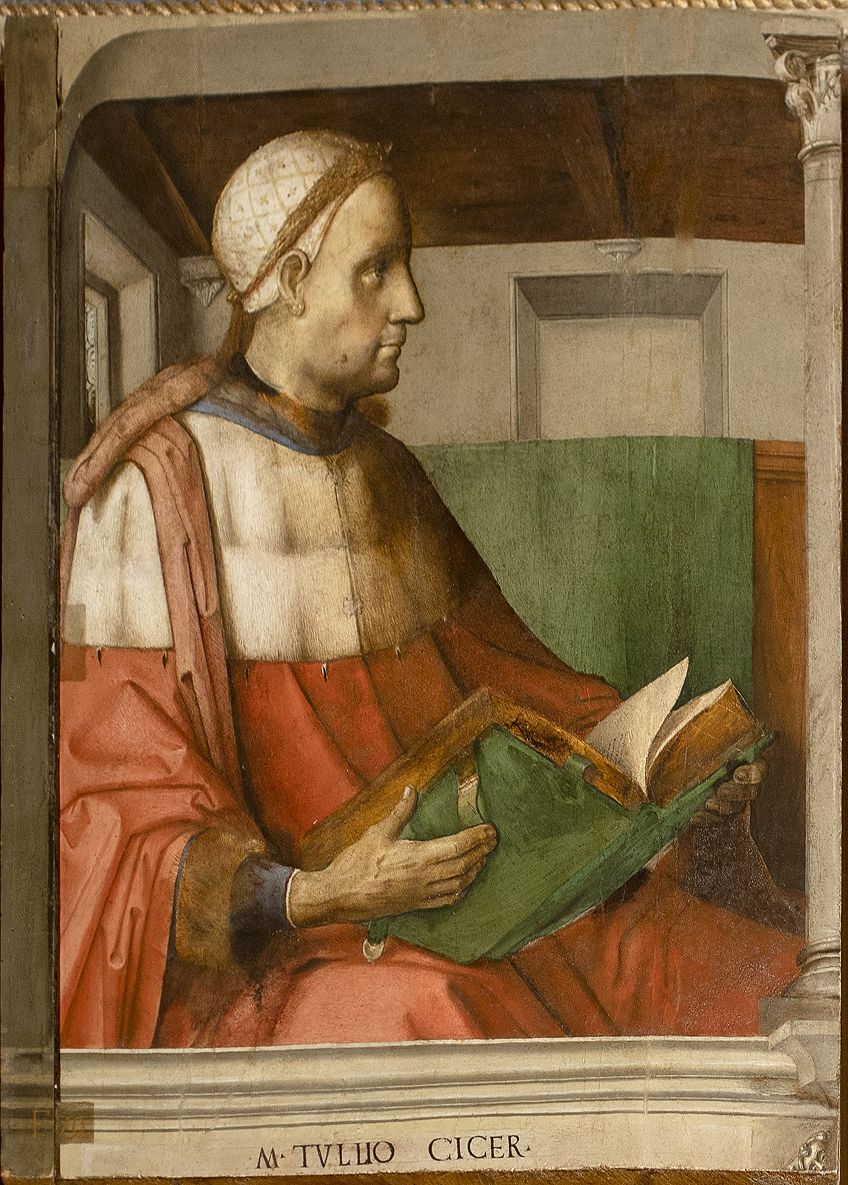 1000 Tullio Cicer (Cicerone)(c. 1472-1476) by Justus van Gent and Pedro Berruguete;Justus van Gent, Public domain, via Wikimedia Commons
1000 Tullio Cicer (Cicerone)(c. 1472-1476) by Justus van Gent and Pedro Berruguete;Justus van Gent, Public domain, via Wikimedia Commons
It is no doubt that the depth of cognition and wisdom that came from Cicero's works and ideas sparked new insights in Petrarch when he constitute these Classical texts. In fact, it ready the foundation for the Italian Renaissance and the return to the Classical era's values and virtues.
It is too important to note that these ideas were discovered in many other Classical texts and not but from the ideas of Cicero alone.
"The Begetter of Humanism"
Petrarch was known as the "Father of Humanism" because of his contribution to this new fashion of perceiving human being in relation to God. Although he was a Catholic and religious man, he also believed in man'southward inherent abilities and greatness. He believed that God gave humans these abilities to live a virtuous life. This may have gone against what the church building believed of man, who was said to be in need of God'due south mercy.
 Portrait of Petrarch (16th century) by Giorgio Visari;Sailko, CC By 3.0, via Wikimedia Commons
Portrait of Petrarch (16th century) by Giorgio Visari;Sailko, CC By 3.0, via Wikimedia Commons
Furthermore, Petrarch's interest in these new ethics also allowed other religious figures to involve themselves in it, which bridged a gap, so to say, between religion and the humanists' ideals. For Petrarch, humanist ideals were about developing a better civilization and society with morally guided human beings who able to become beyond illiteracy and the confines of the preceding Middle Ages.
This especially pertained to the tenets of Scholasticism, which was the dominant methodology for learning from around 1100 CE to 1600 CE.
During the fourteenth and xvthursday centuries, more people became educated in humanist ideals. The Latin school called studia humanitatis sought to educate in five major disciplines, namely grammar, history, verse, moral philosophy, and rhetoric. Rhetoric was a major component of these studies and many people learned from other ancient Greek and Roman texts.
The Other "Forefathers" of Humanism
There were other scholars who contributed to the Renaissance humanist ideals and were seen as the "forefathers" of this move forth with Petrarch. These include the writers Dante Alighieri and Giovanni Boccaccio. However, Voigt also believed that Dante was not quite a matching counterpart to Petrarch in terms of Humanism considering he came from the before Medieval catamenia.
Dante wrote the Divine Comedy (1308 to 1320), a text about the afterlife cogitating of Medieval beliefs. It is an influential text known for setting the foundations of Italian literature. It besides contributed to the humanist motility – a slight shift away from solely religious sources – by including inspiration from Classical writers and philosophers like Virgil and Ovid.
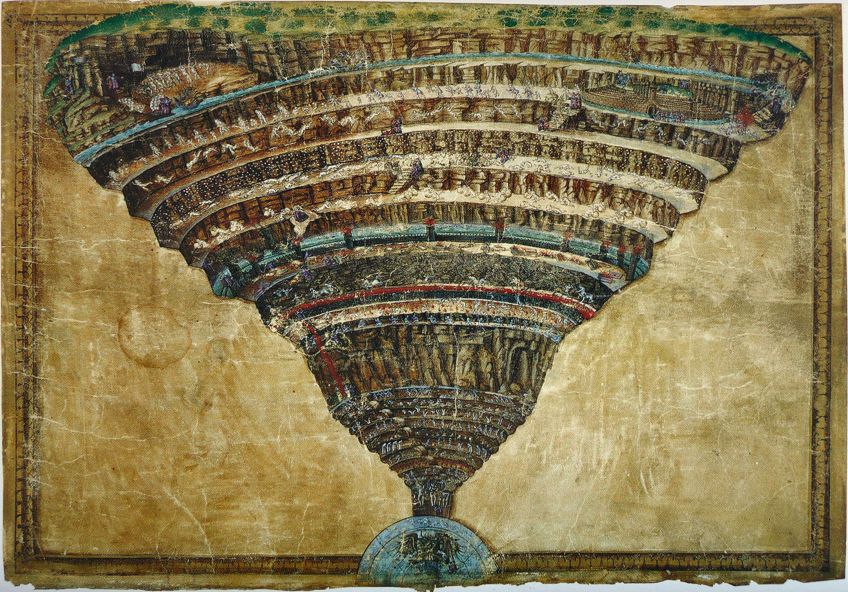 Analogy of the structure of Hell past Sandro Botticelli, between 1480 and 1490;Sandro Botticelli, Public domain, via Wikimedia Eatables
Analogy of the structure of Hell past Sandro Botticelli, between 1480 and 1490;Sandro Botticelli, Public domain, via Wikimedia Eatables
Boccaccio was some other famous literary catalyst, and friend of Petrarch, inside the humanist movement. He wrote various brusk stories titled, The Decameron (1353), which many people related to considering it pertained to relevant everyday experiences.
He was also influenced by ancient Classical texts and would become, forth with Petrarch and Dante, i of the leading figures in Italian literature. Furthermore, these men wrote in their vernacular (everyday or native tongue), which made the understanding of the concepts easier for those people who did not empathise Latin.
Another important figure in the humanist motion was the Dutchman Desiderius Erasmus. With the help of the newly innovated printing press, which allowed for the spread of ideas from Italy to other parts of Europe, Erasmus was able to disseminate more than copies of Greek and Latin texts, especially of the New Attestation.
 Portrait of Desiderius Erasmus by Albrecht Dürer, engraved in Nuremberg, Germany, 1526;Albrecht Dürer, Public domain, via Wikimedia Eatables
Portrait of Desiderius Erasmus by Albrecht Dürer, engraved in Nuremberg, Germany, 1526;Albrecht Dürer, Public domain, via Wikimedia Eatables
Erasmus was a devout Christian, although his piece of work utilized humanist ideals, and he strongly believed that education should be made available to everyone and not only a select few. Other agents of modify within this movement were scientists and mathematicians like Nicolaus Copernicus, who proposed that the Sun was at the middle of our universe and not the earth.
The Medici family, who were wealthy bankers and patrons of the arts, commissioned numerous artists like Botticelli and Michelangelo to create diverse paintings, sculptures, and pieces of architecture during the Early on and High Renaissance periods.
The Medici family besides contributed to further studies that involved humanist ideals. For example, it was Lorenzo de' Medici who started the Medici Library, besides known as the Laurentian Library. This housed the personal collections of books and manuscripts, as well as classical texts, collected past the Medici family over the years.
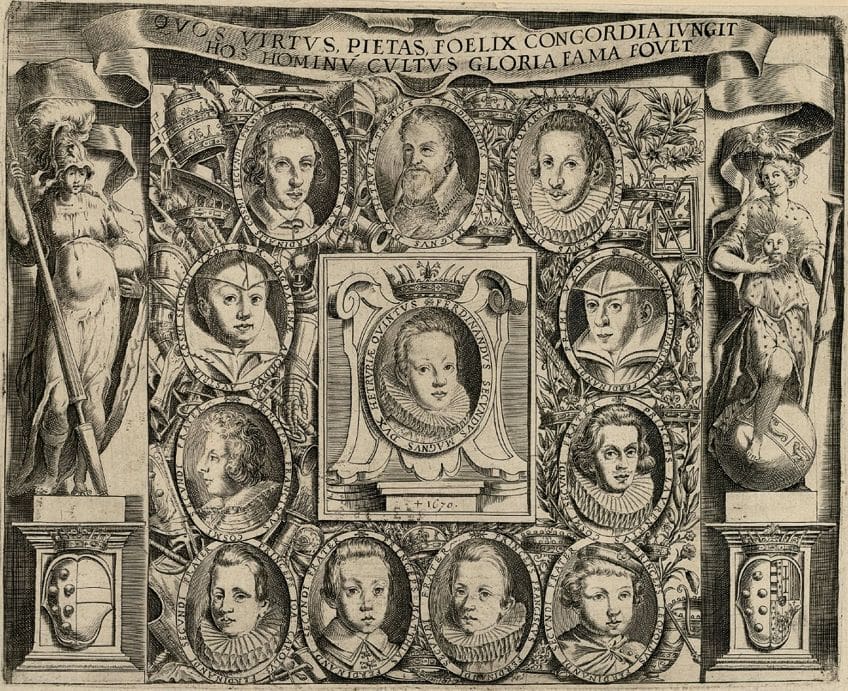 The family of Ferdinando Ii de' Medici, Grand Duke of Tuscany, circa 1621 (unknown artist);Anonymous Unknown author, Public domain, via Wikimedia Commons
The family of Ferdinando Ii de' Medici, Grand Duke of Tuscany, circa 1621 (unknown artist);Anonymous Unknown author, Public domain, via Wikimedia Commons
Platonic Revival
The Accademia Platonica ("Platonic Academy") is believed to have been started and sponsored past Cosimo de' Medici in the mid-1400s. It was like a modernized version of the original Platonic Academy in Athens, which was founded by the Greek philosopher Plato around 387 BC.
Marsilio Ficino, a Catholic priest, philosopher, and scholar, was assigned by Medici as the head of the new school. Ficino also translated all of Plato's texts into Latin and was an important proponent of the Neoplatonic motion. There were numerous members that subscribed to the Neoplatonic thought – Giovanni Pico Della Mirandola is another example. He wrote the philosophical soapbox titled, Oration on the Dignity of Homo (1486), which became i of the nearly important texts within Renaissance Humanism thought.
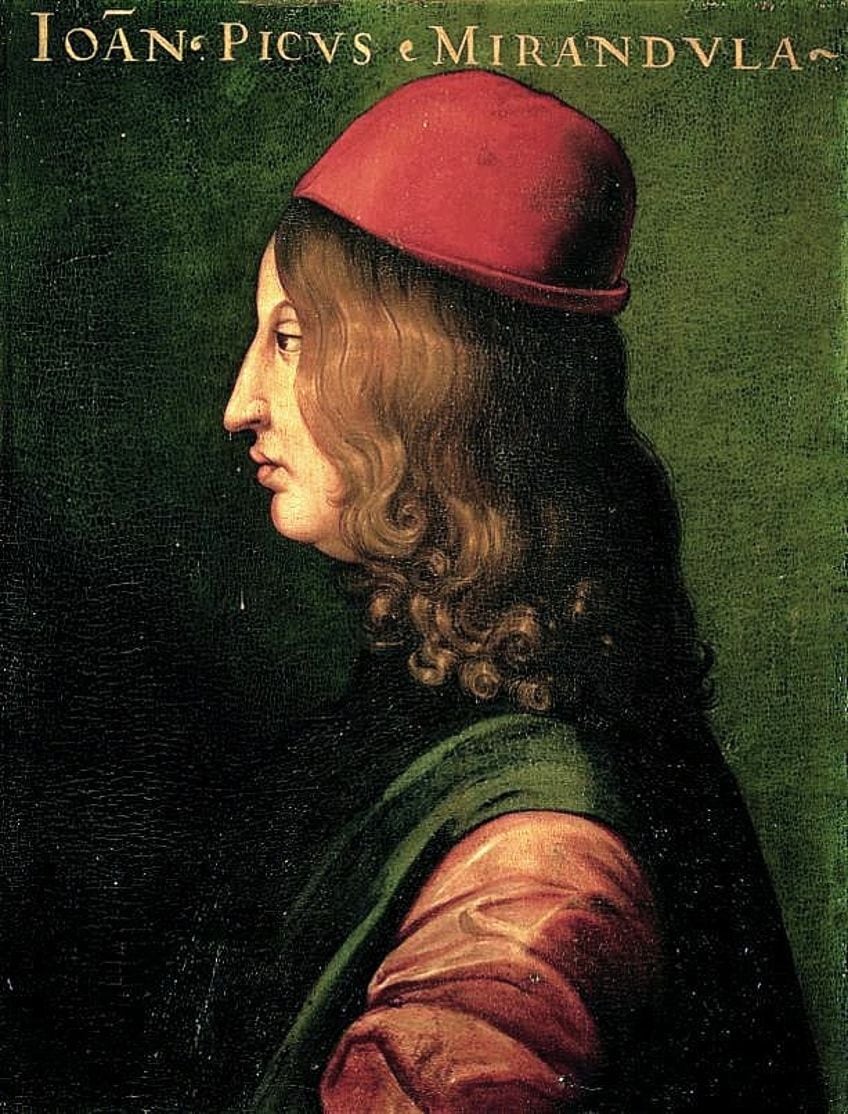 Pico della Mirandola, one of a series of the Medici family and their assembly, c. 1500s;Cristofano dell'Altissimo, Public domain, via Wikimedia Commons
Pico della Mirandola, one of a series of the Medici family and their assembly, c. 1500s;Cristofano dell'Altissimo, Public domain, via Wikimedia Commons
Mirandola's Oration was refuted by the Pope because it was viewed as unorthodox in its ideas, but nonetheless, information technology is oftentimes described equally the "Manifesto of the Renaissance". It explored controversial ideas around the many abilities of humans, and that human being has higher capacities and more than freedom than other animals.
It besides explored the advantages of developing oneself as a homo being through virtues like justice and reason. Mirandola too mentions magic and the Kabbalah. Overall, he emphasizes the uniqueness of being homo and the aim to transcend this life. The act of transcending this life will come from virtuous living and choices made from higher faculties.
The return to the Classics was a pregnant addition to and development of Renaissance Humanism.
The Medici family'due south love of fine art and the Classical era furthered the dissemination of the Classical ideals among society beyond Florence, specially in the course of translated texts (from Greek to Latin). Furthermore, it was a great discovery in and of itself because it revived Classical texts that were lost for hundreds of years after the closure of Plato's School in Athens.
Humanism Art
The Humanism art definition can be described as art that spans painting, sculpture, and architecture during the Early and High Renaissance periods, underpinned by humanistic ideals. Many artists during this time drew inspiration and cognition from texts past Classical writers and practitioners in disciplines like architecture and sculpture.
Artists during the Renaissance drew from primal humanistic principles, which shaped and informed their art. Many of these principles were based around the ideas of dazzler, proportions, guild, and rationality.
An important part of humanistic art is that art and science became interdependent disciplines; in other words, art was created with a scientific foundation and perspective, which informed its beauty and composition. Below, we look at some of the artistic techniques and concepts that developed, including the leading figures who explored them.
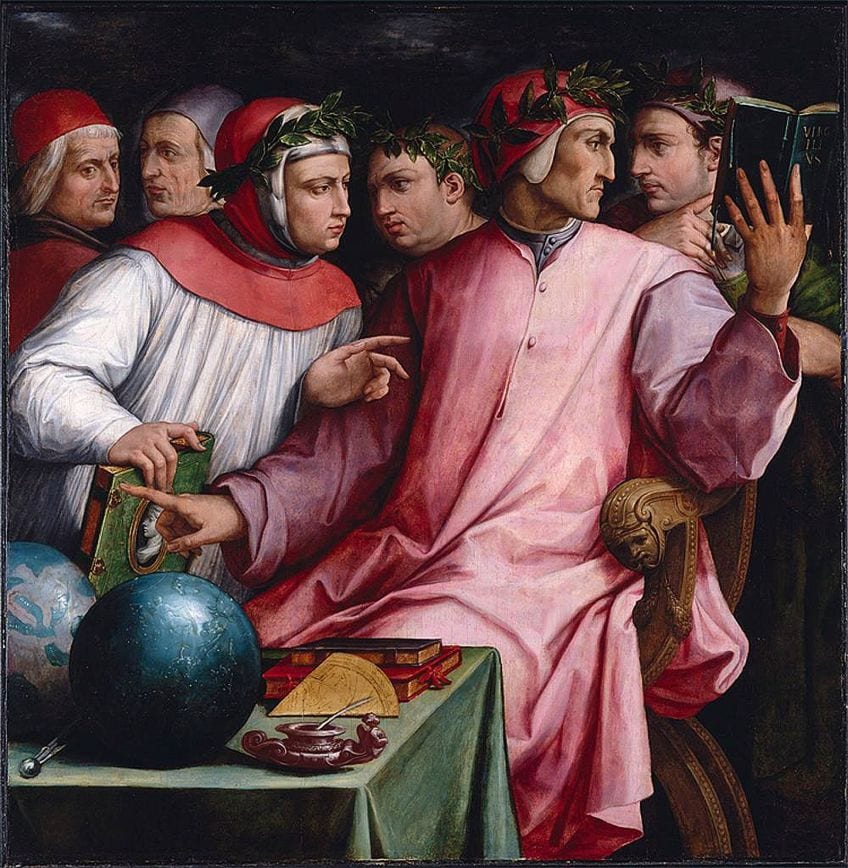 Italian Humanists (Six Tuscan Poets)(1544) by Giorgio Vasari, featuring (from left to right) Dante Alighieri, Giovanni Boccaccio, Petrarch, Cino da Pistoia, Guittone d'Arezzo, and Guido Cavalcanti;Giorgio Vasari, Public domain, via Wikimedia Commons
Italian Humanists (Six Tuscan Poets)(1544) by Giorgio Vasari, featuring (from left to right) Dante Alighieri, Giovanni Boccaccio, Petrarch, Cino da Pistoia, Guittone d'Arezzo, and Guido Cavalcanti;Giorgio Vasari, Public domain, via Wikimedia Commons
The "Vitruvian Triad" and the "Vitruvian Homo"
The Roman architect, writer, and engineer, Marcus Vitruvius Pollio (as well just known as Vitruvius) was active during the 1st Century BC. He was widely studied by Renaissance scholars and artists. His ideas contributed to how artists would design buildings and draw and pigment the human form.
Vitruvius' treatise, De architectura ("On Compages") (c. 27 BCE) was a compilation of ten books that discussed Classical compages and the Greek Orders, Roman architecture (including public and private buildings), building machinery, planning, decoration, and more.
What was significant near Vitruvius' work was his holistic view on architecture and how it should impact people and the environment, as some sources state the "theoretical" and "practical" understanding of architecture was of import to Vitruvius.
He introduced three characteristics or virtues, known as the "Vitruvian Triad", to emphasize what a building or structure should look like, namely, firmitas ("stability" or "strength"), utilitas ("usefulness" or "utility"), and venustas ("beauty").
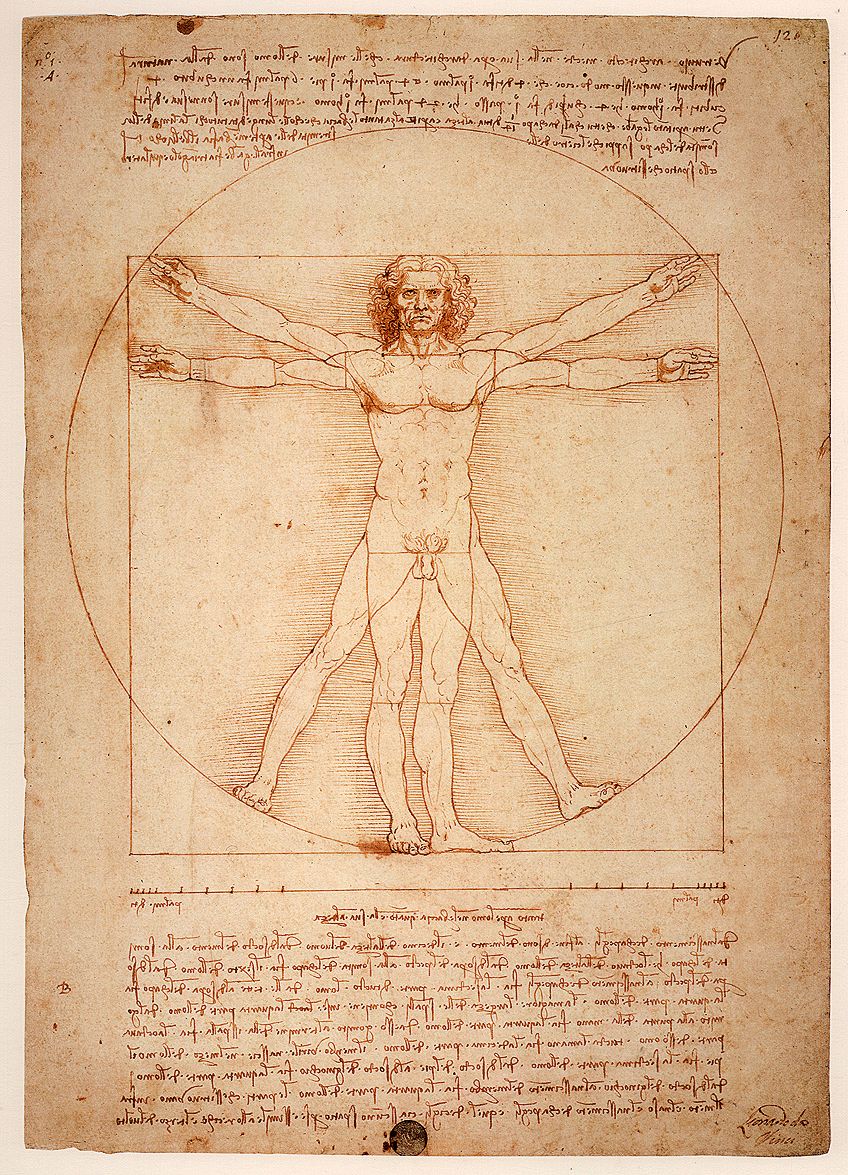 Vitruvian Man (1490) past Leonardo da Vinci;Leonardo da Vinci, Public domain, via Wikimedia Eatables
Vitruvian Man (1490) past Leonardo da Vinci;Leonardo da Vinci, Public domain, via Wikimedia Eatables
Vitruvius influenced several Renaissance artists, including the famous Leonardo da Vinci who painted the Vitruvian Man (c. 1485), which is also termed the Catechism of Proportions. This painting depicts two poses (often described as superimposed) of a nude male effigy continuing with outstretched arms and legs that touch the edges of a circumvolve and square around him.
This work is washed according to the proportions stipulated by Vitruvius himself, although da Vinci likewise made corrections to the proportions. Beneath the image, we also discover written notes by da Vinci describing what Vitruvius was aiming for in his proportions of man. This illustration is the epitome of Renaissance Humanism, every bit it applies both the practical principles from mathematics and scientific observation and the balance and beauty from the perfect proportions.
Furthermore, information technology besides emphasizes homo'due south central identify in the universe; the square symbolizes the earth, and the circumvolve symbolizes the sense of unity and oneness.
Linear Perspective
Linear perspective, or One-Betoken Perspective, was another new discovery made during the Early on Renaissance. It was Filippo Brunelleschi, an Italian builder, sculptor, and engineer, who provided a mathematical study of how perspective worked. Although he was too a sculptor, he was more of an architect and pioneered the One-Point Perspective technique, which continued influencing many other Renaissance painters like Masaccio, Lorenzo Ghiberti, and Leon Battista Alberti (who was a close friend and follower of Brunelleschi).
Alberti was a significant contributor to modalities like painting, sculpture, and architecture. He provided theoretical frameworks and systems from his three treatises for artists that would place them above the more common designation of being simply craftsmen – they would go studied and intellectual artisans of their crafts.
Alberti's three treatises wereDella pittura (1435) ("On Painting"), De re aedificatoria (1452) ("On Compages"), and De statua (1464) ("On Sculpture"). These were some of the get-go theoretical publications on the different modalities of art, each one providing principles and techniques for artists.
 The preface of Leon Battista Alberti'southDe re aedificatoria ('On Compages'), 1443-1452;Biblioteca Europea di Informazione e Cultura, Public domain, via Wikimedia Commons
The preface of Leon Battista Alberti'southDe re aedificatoria ('On Compages'), 1443-1452;Biblioteca Europea di Informazione e Cultura, Public domain, via Wikimedia Commons
"The Renaissance Man"
"The Renaissance Man" is an important concept that is a big part of what defines Renaissance Humanism, as it exemplifies someone who tin accomplish what they desire and excel at many disciplines. This was truthful of many artists during the Renaissance, who were known as polymaths.
Alberti was among these and known as the first to introduce the concept of "Uomo Universale", which is the Italian term for Universal Human being, stating in his writings that "a human being tin can do all things if he volition".
Leonardo da Vinci, Michelangelo, and many others were too polymaths and excelled in painting, sculpture, architecture, engineering science, cartoon, inventing, poetry, literature, music, scientific discipline, mathematics, phytology, geology anatomy, and more than. This placed the artist at a level of genius and the man every bit a central powerful strength in the universe.
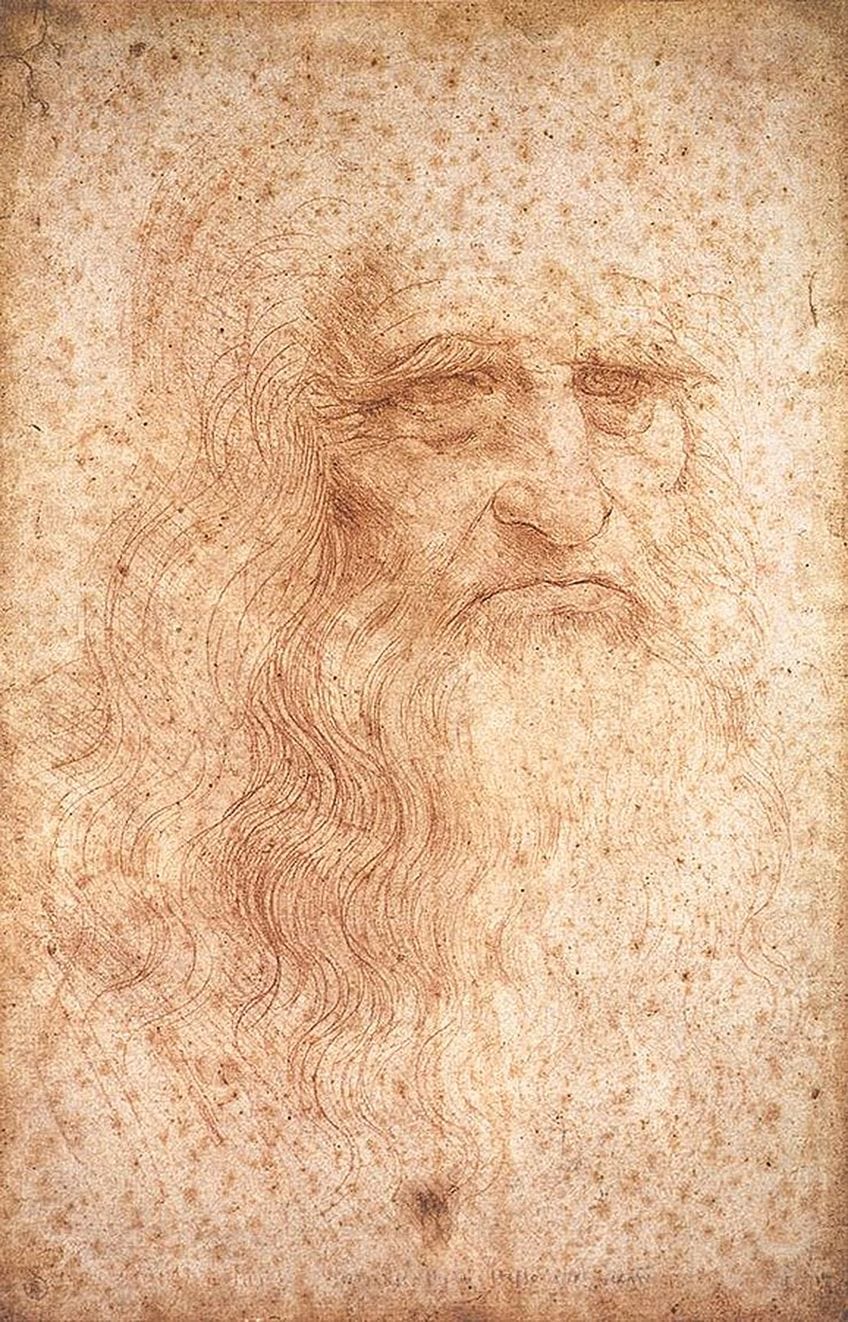 A presumed self-portrait of Renaissance man Leonardo da Vinci, c. 1512;Leonardo da Vinci, Public domain, via Wikimedia Eatables
A presumed self-portrait of Renaissance man Leonardo da Vinci, c. 1512;Leonardo da Vinci, Public domain, via Wikimedia Eatables
Famous Renaissance Humanism Artwork
Below, we discuss some of the more famous Renaissance Humanism artworks spanned across the Renaissance time menses. Nosotros will commencement from the Early Renaissance, during the 1400s, followed by the Loftier Renaissance during the late 1400s to 1500s, and then mention some of the prominent artworks from the Northern Renaissance, which occurred during the 1500s.
Early Renaissance
There were numerous artists during the Early Renaissance, and nosotros can start to see the emergence of Humanism ideals in how artists approached and redefined the subject area thing they worked with. For instance, religious or biblical figures were given more than naturalistic qualities, which made the artwork easier to relate to. The arcadian portrayal of divine figures from the prior Byzantine menses was replaced with perfectly proportioned figures, often muscular in shape and with a radical human being likeness.
Furthermore, artists started incorporating perspective in their compositions and created more depth and three-dimensionality by using mathematically based techniques and light sources.
Filippo Brunelleschi (1377 – 1446)
Filippo Brunelleschi designed the dome for the Cathedral di Santa Maria del Fiore (1296 to 1436) in Florence. This cathedral was ane of the about pregnant buildings during the Early Renaissance and is an exemplary construction that gives life to humanistic ideals. It embodies mathematical accuracy in its proportions while simultaneously standing at 372 feet alpine in its cherry-red brick beauty.
Brunelleschi congenital the dome in an innovative way, building a dome inside a dome in order to create enough back up for the building to prevent the dome from falling in on itself. He also designed new mechanics to assist during the edifice process.
 A cutaway of Filippo Brunelleschi's Dome of Florence Cathedral (Santa Maria del Fiore), 1414-1436; Public Domain, Link
A cutaway of Filippo Brunelleschi's Dome of Florence Cathedral (Santa Maria del Fiore), 1414-1436; Public Domain, Link
This building is a testament to Brunelleschi's skills in combining not only his knowledge of Classical architecture but also mathematical principles in lodge to create something similarly cute.
Other buildings past Brunelleschi include his public building, Ospedale degli Innocenti (significant "Infirmary of the Innocents"), which he started in 1419. The design was influenced past Roman compages, late Gothic, and Italian Romanesque styles. This edifice is another instance of the order and harmony portrayed in the structure and layout of columns, capitals, and archways.
Donatello (1386 – 1466)
Donatello was a sculptor during this period, famous for his statuary statue titled David (1440 to 1443). Information technology is described as an "iconic" humanistic art slice considering of the mode Donatello portrayed the biblical effigy of David.
Firstly, this is a nude, free-standing statue of a male person figure – the last time we saw nude statues was during the Classical era. The semi-erotic and youthful biblical effigy stands with the head of Goliath between his legs, a sword in his right hand, and his left hand resting on his left hip.
 Donatello's bronze David statue, 1440-1443;Donatello, CC By-SA 2.0, via Wikimedia Eatables
Donatello's bronze David statue, 1440-1443;Donatello, CC By-SA 2.0, via Wikimedia Eatables
What makes the effigy more erotic in nature is his effeminate trunk shape, long hair, and softer appearance equally opposed to what we would await from someone who had just killed a Goliath. Additionally, he has a laurel wreath in his hat and well-designed boots. His stance is in the classical contrapposto pose, which is a characteristic of many figures during the Renaissance era. It as well gives a new sense of movement and relaxation to the figures.
This was some other revival of techniques from the Classical era.
Paolo Uccello (1397 – 1475)
Paolo Uccello brought perspective, vanishing points, and light to life in his painting The Battle of San Romano (1435 to 1440) – another testament of humanistic art. This painting is part of 3 panels, depicting a battle scene between the Florentines and Sienese.
 The Boxing of San Romano (c. 1438) past Paolo Uccello;Paolo Uccello, CC BY-SA 3.0, via Wikimedia Commons
The Boxing of San Romano (c. 1438) past Paolo Uccello;Paolo Uccello, CC BY-SA 3.0, via Wikimedia Commons
Examples of how Uccello portrayed perspective include the ruby-red and white lances on either side of the limerick, almost leading our optics to the vanishing indicate in the distance. This is further led by the lines from foliage in the afar fields. The foreground is total of action with hitting reds, blues, and whites crowding the infinite.
Other examples of Uccello's artwork include St George and the Dragon (c. 1455 to 1460) and the Hunt in the Forest(1468 to 1470). The latter is some other example of Uccello's skillful utilization of linear perspective. Nosotros discover various figures, some on horses and on pes, with dogs running in the foreground moving into the receding woods ahead. This creates a sense of movement and three-dimensionality.
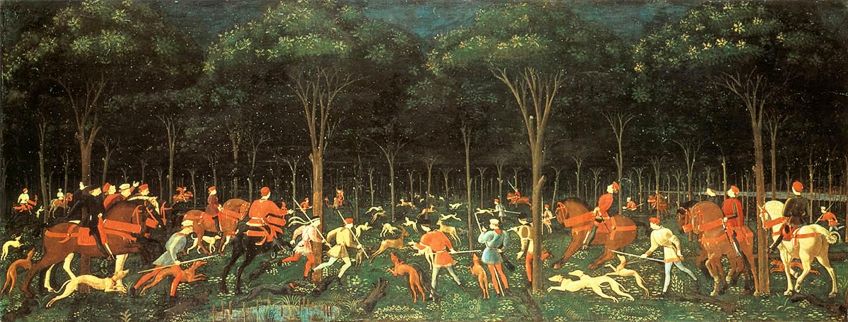 The Hunt in the Forest(1470s) by Paolo Uccello; Paolo Uccello, Public domain, via Wikimedia Eatables
The Hunt in the Forest(1470s) by Paolo Uccello; Paolo Uccello, Public domain, via Wikimedia Eatables
It is also important to note that Uccello painted in the Late Gothic mode, and did not paint in the typical style we see in other Humanistic art, where figures are characteristically classical and portrayed with naturalism. What fabricated his artwork stand up out within the Humanism field was his precise preoccupation with linear perspective and utilization of color to create a heightened effect on the subject affair.
Masaccio (1401 – 1428)
The artworks by Masaccio, a Florentine painter, give a good case of how artists started incorporating perspective and naturalism in their subject matter and compositions. It is because of this that Masaccio is known as the "Father of the Renaissance".
We can conspicuously observe the move away from the Gothic way that preceded this period of "rebirth".
Masaccio'due south Payment of the Tribute Money (1425 to 1427) was washed for the Brancacci Chapel of the Santa Maria del Cherry-red and is part of a series of other paintings with religious themes. We notice that the artist is focusing on 3 narratives here (referred to as a continuous narrative) about the life of St. Peter.
The key figures are Christ with his disciples and the tax collector asking for payment. We observe Jesus pointing to Peter to collect the money. To the left of the painting, Peter is taking the money from a fish'southward mouth, and to the right of the painting, nosotros see him paying the tax collector.
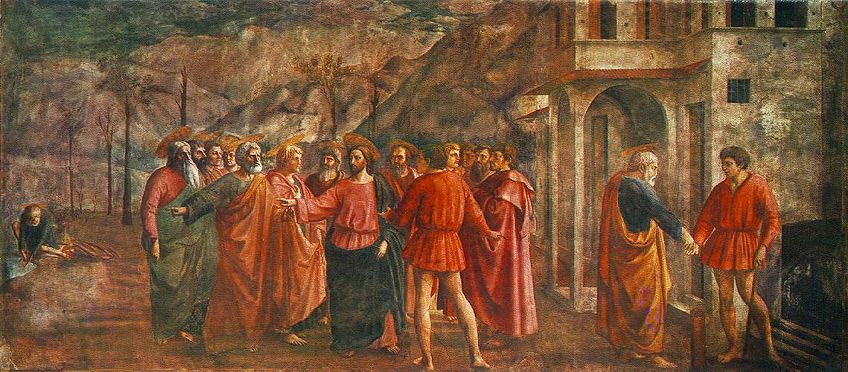 Payment of the Tribute Money (1426-1427) past Masaccio;Masaccio, Public domain, via Wikimedia Eatables
Payment of the Tribute Money (1426-1427) past Masaccio;Masaccio, Public domain, via Wikimedia Eatables
There are diverse characteristics in this painting that suggest it is an instance of humanist thought or influence. Namely, the figures are portrayed in a classical manner, evident by their draping robes, appearing as if they are statues from Antiquity. However, there is besides a naturalism in their expressions and stances, which highlights their humanness.
Furthermore, Masaccio incorporated linear perspective and proportion in the landscape in the distance and in the architectural designs of the buildings in the foreground.
There is also a low-cal source evident by how the creative person depicted the bandage shadows past the feet. This was another revolutionary feature of Masaccio's painting considering it indicates a sense of weather and gives the whole limerick a 3-dimensionality never seen before.
Alessandro Botticelli (1445 – 1510)
Otherwise known as Botticelli, we discover the motility abroad from strict religious figures in his famous paintings La Primavera (c. 1482 to 1483) and The Birth of Venus (c. 1484 to 1486). Both paintings draw classical mythological scenes of the goddess Venus surrounded by numerous other gods and goddesses.
In La Primavera, we see the central figure of Venus, and to her left is the goddess of Spring, Primavera, and Chloris, a nymph, pursued past the god of air current, Zephyrus. To Venus' correct are the god Mercury and three dancing graces. Above Venus' caput is the smaller figure of Cupid shooting an arrow towards the three graces.
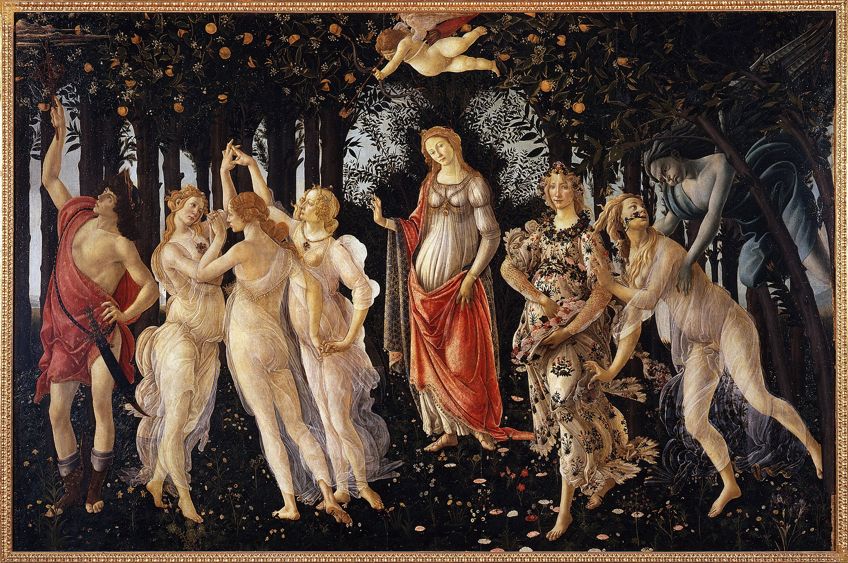 La Primavera ('Bound', c. 1480) by Sandro Botticelli;Sandro Botticelli, Public domain, via Wikimedia Commons
La Primavera ('Bound', c. 1480) by Sandro Botticelli;Sandro Botticelli, Public domain, via Wikimedia Commons
This painting is too believed to bespeak the influences of Neoplatonic thought. Some sources suggest that the painting solely focuses on aesthetics and honey (tied to the beliefs posited by Plato), evident by the composition and how the subject area affair is arranged in a beautiful manner, from the figures all the manner to the flowers strewn on the ground.
Other sources suggest the painting depicts narratives from Ovid, who was a Roman poet alive during the time of Emperor Augustus. Ovid was as well regarded as one of the all-time Roman poets, along with Virgil and Horace, in the field of Latin literature. Furthermore, Botticelli was also exposed to the humanistic movement of the time and a follower of Dante's work, as well as the philosopher Marsilio Ficino, who translated Plato's texts.
This provides more than context for Botticelli's rich humanistic art.
Loftier Renaissance
Starting around 1490 to 1527, the High Renaissance was a period of refinement of many of the techniques from the Early on Renaissance. Some artists also pioneered new techniques, for example, da Vinci's sfumato, and used new media like oils. This menses in the Renaissance was almost like the epitome of artistic virtue and genius.
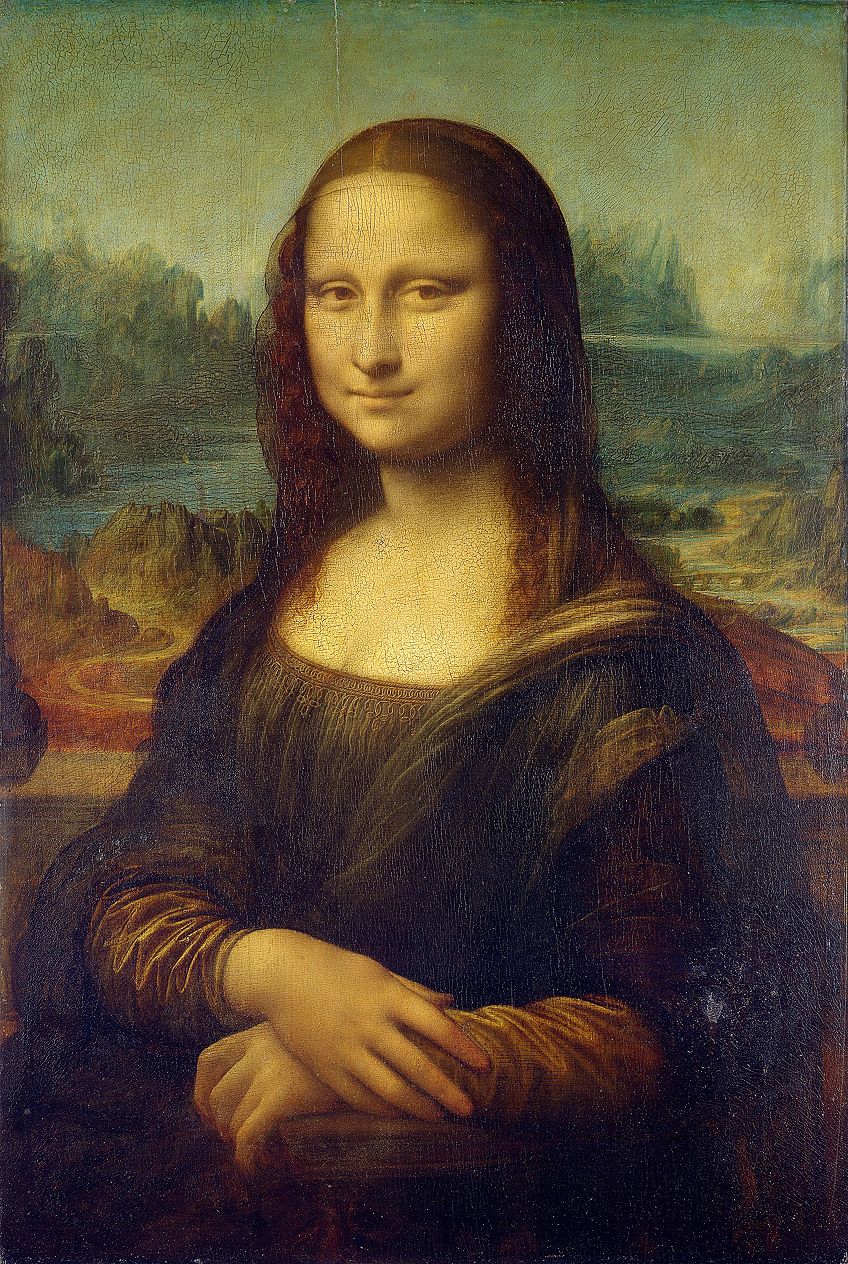 You can see the utilize of the sfumato technique in Leonardo da Vinci's Portrait of Mona Lisa del Giocondo (1503-1506);Leonardo da Vinci, Public domain, via Wikimedia Eatables
You can see the utilize of the sfumato technique in Leonardo da Vinci's Portrait of Mona Lisa del Giocondo (1503-1506);Leonardo da Vinci, Public domain, via Wikimedia Eatables
There were many artists who created masterpieces of art, just three have taken the spotlight, then to say. This was Leonardo da Vinci, Michelangelo, and Raphael. Another artist includes Donato Bramante, who was a leading architect of the fourth dimension. The High Renaissance saw artists taking the stage as embodiments of the "Universal Man" or "Renaissance Man", the cadre tenet of Humanism. Artists were considered geniuses; many were polymaths and excelled at a plethora of disciplines beyond fine art, indeed, personifying the Humanism civilization.
Below, nosotros look at some of the famous humanistic fine art from this menstruum.
Leonardo da Vinci (1452 – 1519)
Da Vinci produced many masterpieces during his time, some including the famous Mona Lisa (1503 to 1506), Salvatore Mundi (c. 1500), The Terminal Supper (1498), and Virgin of the Rocks (1483 to 1486). In da Vinci'due south paintings, there is a heightened sense of naturalism, noticed in each figure's stance and facial features. There is also a mysterious quality in how the artist portrayed sure facial expressions, which nosotros tin can see in the Mona Lisa's hint of a smiling as she gazes at us from her seat.
In Virgin of the Rocks, da Vinci portrays religious subject matter. However, it is with an chemical element of mystery, once again, due to the unknown rocky, cavern-like groundwork behind the Virgin Mary, who is sitting with the baby figures of Christ and John the Baptist, and the archangel Gabriel.
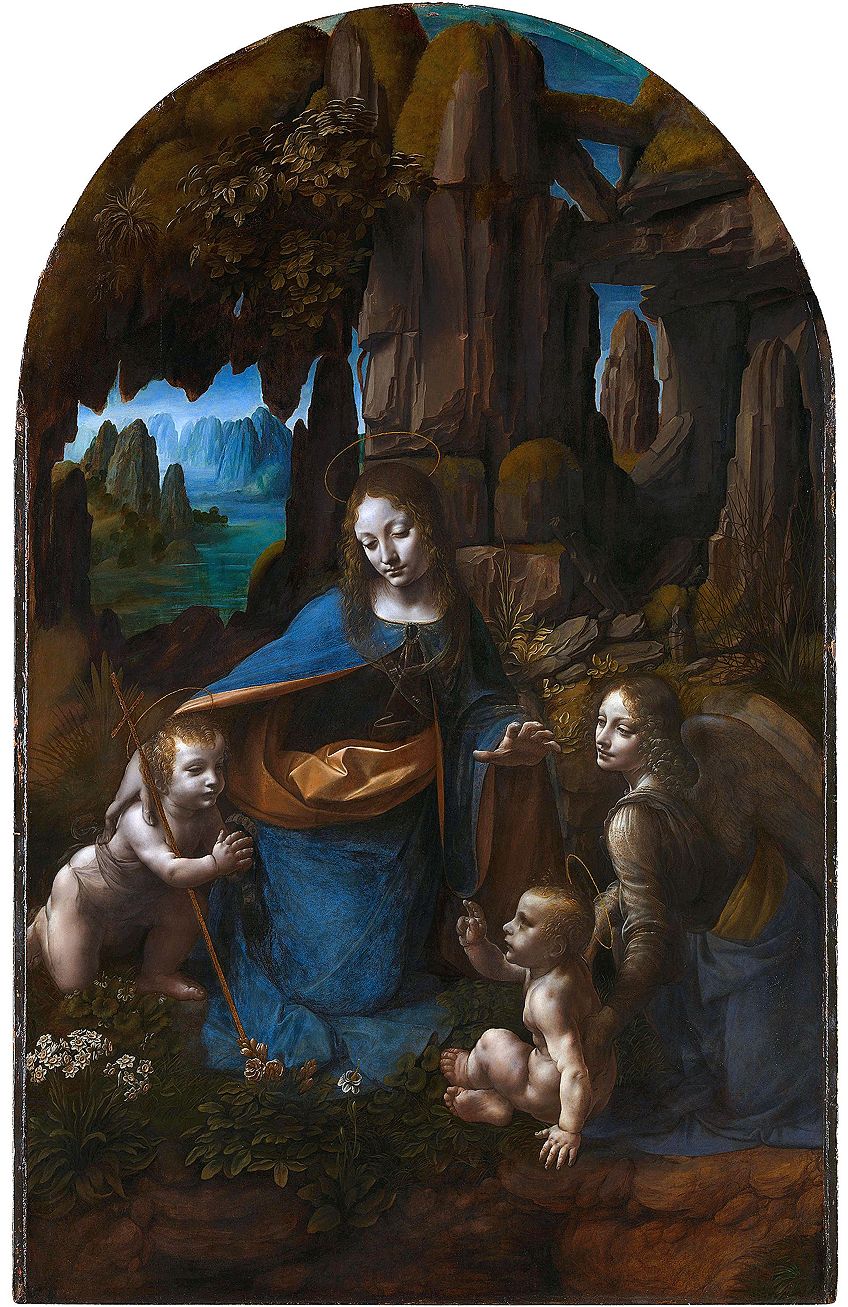 Virgin of the Rocks (1483-1486) by Leonardo da Vinci; Leonardo da Vinci and workshop, Public domain, via Wikimedia Eatables
Virgin of the Rocks (1483-1486) by Leonardo da Vinci; Leonardo da Vinci and workshop, Public domain, via Wikimedia Eatables
In this painting, nosotros notice da Vinci's skilled craftsmanship (or genius) at painting. He creates three-dimensionality with numerous techniques like sfumato, which blends the lighter and darker colors to give the composition an intensity and emotiveness.
Although nosotros see the portrayal of religious subject field matter throughout da Vinci'due south works, he does not create a sense of idealism in the figures. He almost brings the figure down to earth, making them appear human-similar, which is something everyone can relate to.
Described as "humanizing the secular", da Vinci's work is a clear case of humanistic art.
Michelangelo (1475 – 1564)
Michelangelo's David (1501 to 1504) is another masterpiece indicative of Humanism ideals. Information technology is the figure of David with a slingshot over his left shoulder. This is a marble statue of the biblical figure, although information technology is embellished with the classical contrapposto stance, as well equally the fact that it is the first nude marble sculpture since Antiquity.
Michelangelo is almost transporting us back to the Classical era, where marble statues of muscular nude males were the epitome of the human effigy. In fact, this statue is estimated to stand up at over 17 feet tall and is a perfect depiction of the platonic male form, in turn, condign the perfect delineation of dazzler.
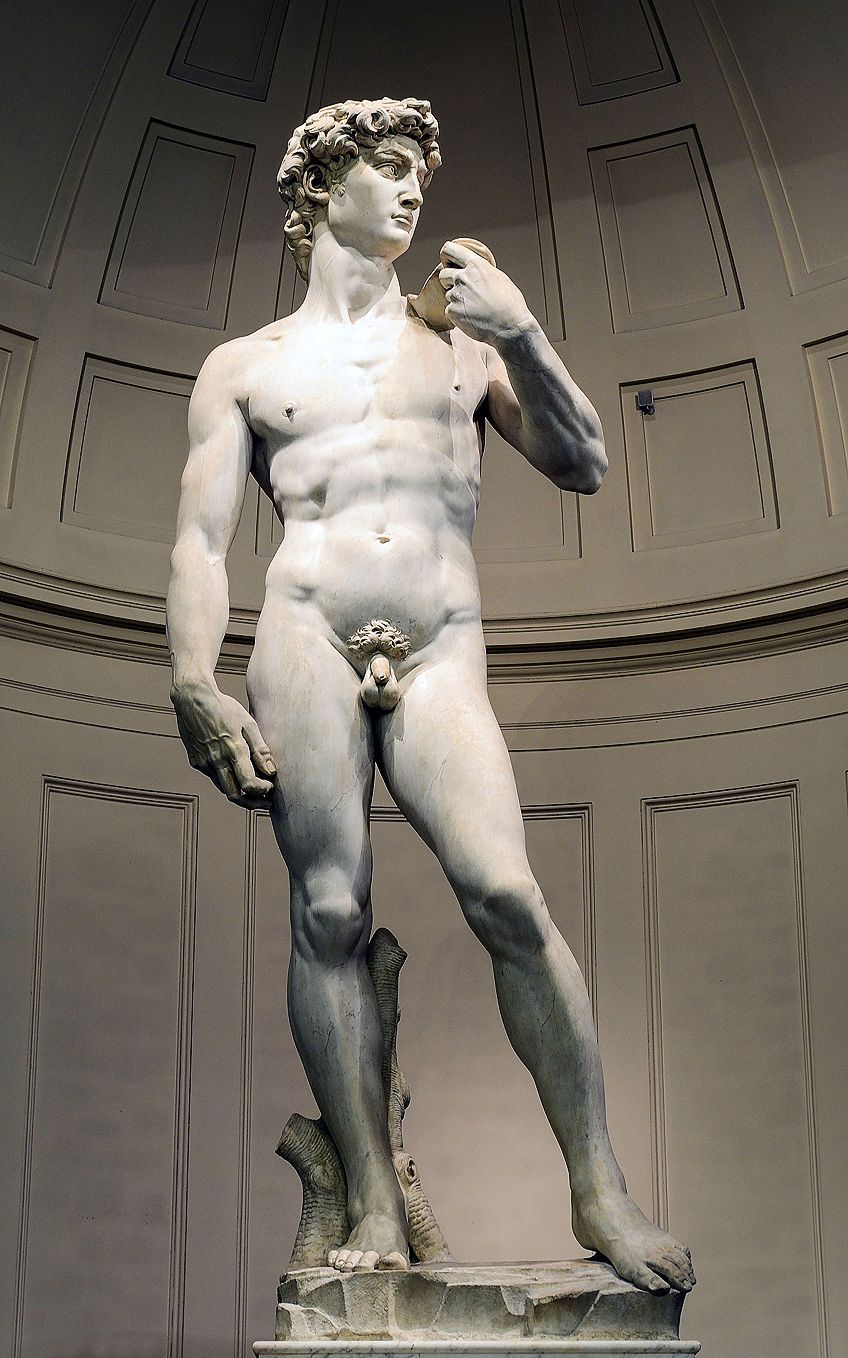 David (1501–1504) by Michelangelo, Accademia di Belle Arti, Florence, Italy;Livioandronico2013, CC Past-SA iv.0, via Wikimedia Commons
David (1501–1504) by Michelangelo, Accademia di Belle Arti, Florence, Italy;Livioandronico2013, CC Past-SA iv.0, via Wikimedia Commons
Raphael (1483 – 1520)
In Raphael'due south School of Athens (1509 to 1511) we are reminded once more of Classical revival. The whole composition is Classical in nature, depicting various philosophers talking and contemplating. The surroundings are likewise suggestive of classical architectural structures, for instance, the columns and arches, including the design beingness of a Greek cross.
Plato and Aristotle are the two central figures. Other famous Greek philosophers include Pythagoras, Ptolemy, and Euclid, among others. There appears to be a fluid discourse between all the figures, besides suggesting the amalgamation of the various disciplines of the humanities and the avid desire to larn near all types of intellect.
There are 2 statues, the Greek god Apollo to the left and the goddess Athena to the right. Each corresponds to the two primary philosophers in the center (Plato and Aristotle). The composition is also dynamic, and nosotros nearly experience a part of the humming oversupply – the arch bordering the scene in the foreground suggests almost as if it is a stage we can walk onto any moment.
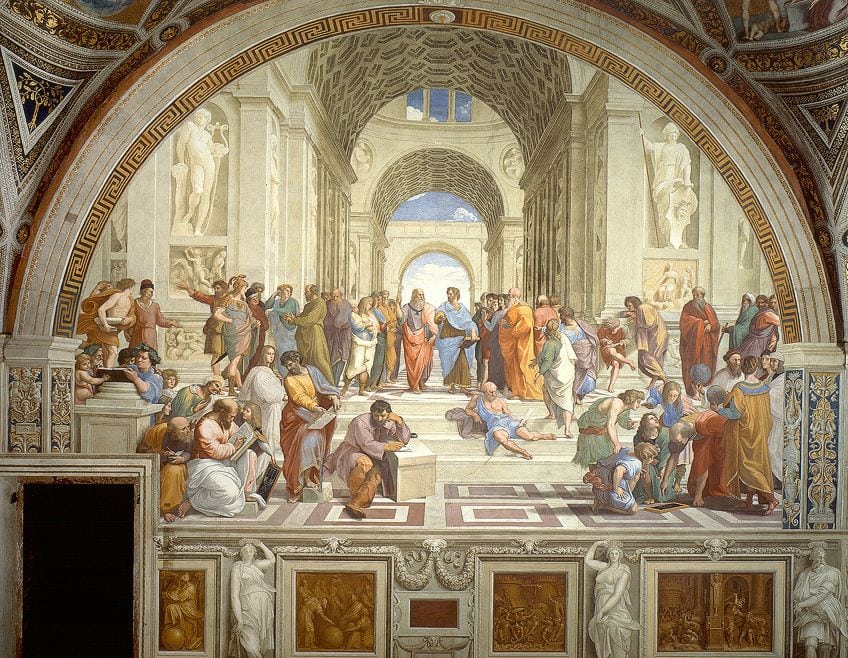 Scuola di Atene ('School of Athens', 1511) by Raphael, fresco at the Raphael Rooms, Apostolic Palace, State of the vatican city;Raphael, Public domain, via Wikimedia Eatables
Scuola di Atene ('School of Athens', 1511) by Raphael, fresco at the Raphael Rooms, Apostolic Palace, State of the vatican city;Raphael, Public domain, via Wikimedia Eatables
Northern Renaissance
Artists in the Northern parts of Europe were not as interested in the Classical as the Italian artists were. Nonetheless, Humanism withal prevailed throughout these parts of Europe. Desiderius Erasmus is described as the "Prince of the Humanists". He was a Catholic priest and translator of various texts including the New Testament (1516).
A distinguishing characteristic betwixt the Northern Humanists and Italian Humanists was a focus on creating a personal human relationship with God versus being told by the Church how to relate to God.
There was a turn towards more upstanding means of living, equally well as a focus on more than everyday lifestyles of the ordinary human being as an individual. Nature was also studied and portrayed in artwork, which gave rise to new genres of painting like still lifes, landscapes, and portraiture.
Albrecht Dürer (1471 – 1528)
In Albrecht Dürer's painting titled, Self-Portrait with Fur-Trimmed Robe (1500), we get aware of the Humanist perspective considering the artist is placing himself, every bit an individual, equally the principal bailiwick thing of the painting (compared to how artists were oft secondary in paintings, depicted as figures in the background, with minimal focus on them).
He is gazing correct at us with a serious and stern facial expression, and he is wearing a nighttime brown fur-trimmed coat. His right hand is raised up touching his coat; some sources propose his fingers are reminiscent of a gesture of blessing.
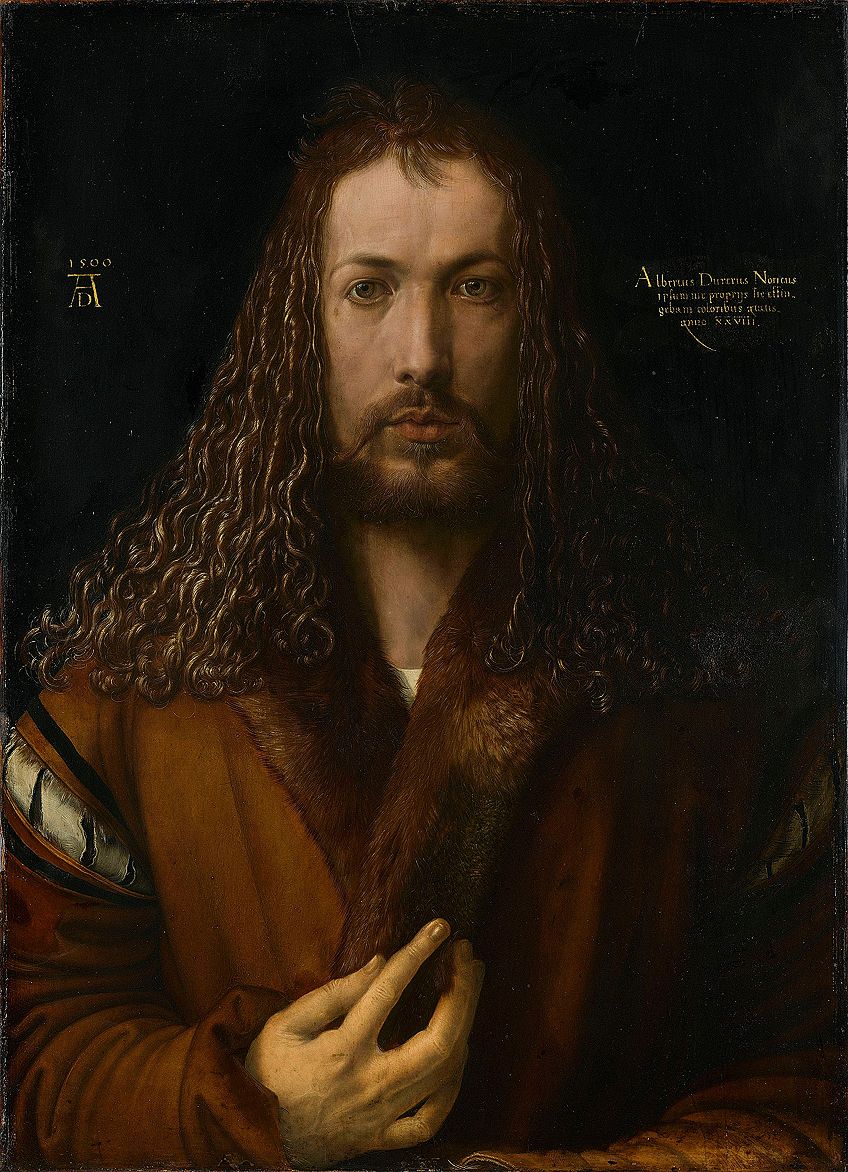 Self-Portrait with Fur-Trimmed Robe (1500) past Albrecht Dürer;Albrecht Dürer, Public domain, via Wikimedia Commons
Self-Portrait with Fur-Trimmed Robe (1500) past Albrecht Dürer;Albrecht Dürer, Public domain, via Wikimedia Commons
The figure appears almost Christ-like, emphasized by his long hair falling neatly down both shoulders. The groundwork is also dark with a lighter side on the right. The creative person utilizes the technique chosen chiaroscuro to depict the transition from calorie-free to dark.
Albrecht Dürer was an important Northern Renaissance artist because he was exposed to the Humanist movement in Italy and was influenced by other artists like da Vinci. He was also a role of Humanist circles in Nuremberg. He explored mathematical concepts like perspective and proportion and wrote several treatises, namely, Four Books on Measurement (1525) and Four Books on Human Proportion (1528).
Across the Human
While Humanism was a cultural evolution, or zeitgeist, and so to say, of the Renaissance era, bringing almost many socio-political changes for the Western civilization, it was also replaced by other movements that did not feel the need to describe perfect proportions or symmetry.
The Mannerist art movement developed shortly after the Renaissance came to an end. Artists started creating subject area matter and figures that were non in proportion with starting time perspectives. At that place was a clear motility away from the classical values of order and harmony from earlier. The art movement after Mannerism was called the Bizarre period, which revisited certain aspects from Renaissance Humanism like naturalism, perspective, likewise as mythological subject affair.
The Renaissance Humanism movement certainly set the stage for new ways of seeing the private, the world, and the universe. It questioned many behavior and perceptions of man's place in the greater scheme of things. Information technology was a cultural blossoming of ideas in about every discipline available, from literature, music, visual arts, and architecture to science, technology, engineering, astronomy, and so much more.
Take a look at our Humanism Renaissance webstory here!
Oftentimes Asked Questions
What Was Renaissance Humanism?
Humanism in the Renaissance was a cultural and intellectual motion during the 13thursday to 16th Centuries CE. It started in Italian republic and its ideas spread across Europe. It was considered a revival of the Classical era'southward philosophies later on the discovery of lost books past Greek and Roman philosophers like Plato.
What Is the Humanism Fine art Definition?
The Humanism art definition tin can be described as art during the Early and High Renaissance periods influenced and informed by the prevalent humanistic ethics of the fourth dimension. Many artists during this fourth dimension drew inspiration and knowledge from texts by Classical writers and philosophers. The ethics of beauty, order, and symmetry underpinned many of the Humanistic artworks.
What Were the Characteristics of Renaissance Humanism?
Humanism in the Renaissance is characterized by the gorging studying of ancient literature from the Classical era, studying languages like Latin, moving away from Scholasticism, providing and believing in education to develop a better man existence, the conventionalities in the power and autonomy of the individual, virtues, ethics, and critical thinking, also as creative exploration in the arts.
henleyquodges1936.blogspot.com
Source: https://artincontext.org/renaissance-humanism/
0 Response to "In What Ways Did Humanism Influece Art Architecture and Social Values Duri G"
Post a Comment